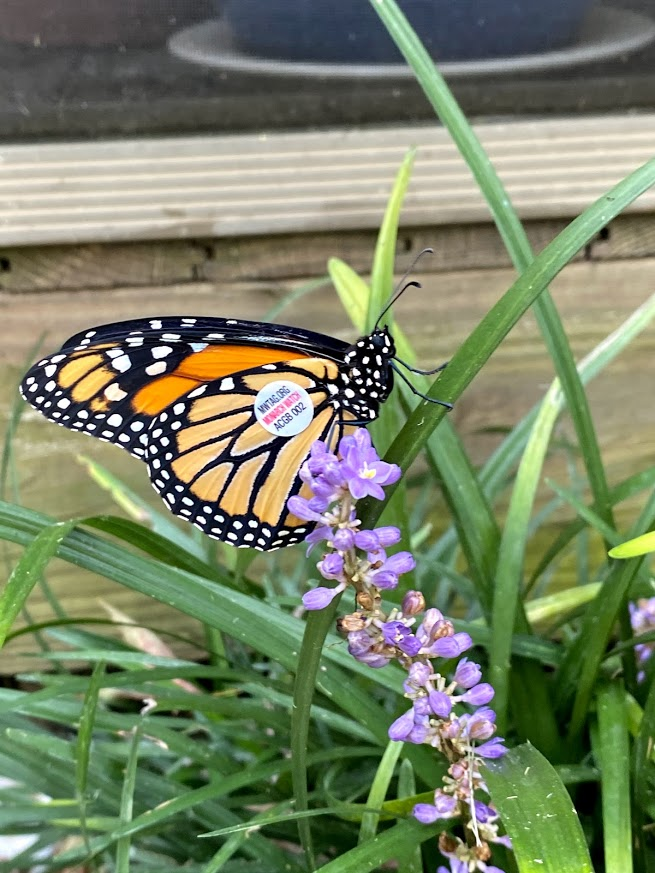
Parklands Monarch in Mexico
Beckley Creek Park, Broad Run Park, Pope Lick Park, The Strand, Turkey Run Park
Parklands’ Monarch makes it to Mexico
In the education department we believe in experiential learning, which means that sometimes our richest educational moments come from things that we do, not the tests we take. This is why we try to base all of our education programs on experiencing the nature around us. Whether it is dipping a net into a creek to see what lives there, or overturning rocks to try to study an animal living on the bank, we believe these experiences have a profound impact that can’t be duplicated in a classroom.
Last fall we decided to add a new experience for our Forest Learning Lab students, tagging monarch butterflies. We set out with butterfly nets in hopes of becoming part of a large-scale citizen science project that helps provide key information to researchers so they can protect and save the declining population of monarch butterflies.
Monarch butterflies make an amazing migration each year, from their overwintering sites in Mexico all the way to Canada. When the weather warms, monarchs will make their journey north within four generations, each generation completing a leg of the trip. The last generation will turn south and make the long journey back to Mexico. So, each fall an organization called Monarch Watch sends out tags to conduct a global citizen science project. The idea is to catch the last generation traveling to Mexico and put a small sticker on their wing, which has a unique code. After tagging, the citizen scientist puts the code, along with key information about the butterfly, into a database. These tags then get retrieved by locals in Mexico at their overwintering sites and turned into Monarch Watch.
From Monarch Watch, “Tagging helps answer questions about the origins of monarchs that reach Mexico, the timing and pace of the migration, mortality during the migration, and changes in geographic distribution. It also shows that the probability of reaching Mexico is related to geographic location, size of the butterfly, and the date.”
While being able to be a part of important research that can help save an amazing species is exciting, another cool part is seeing where the butterflies you tagged might have ended up. Monarch Watch puts out a list of all their recovered tags from the past year in the spring. As a citizen scientist, you can get your list out of all the butterflies you tagged and check it against theirs. The education department was excited to learn that one of the ones we tagged made it on that list! Tag no. ACGB 002 made it to El Rosario, Mexico.
Monarchs are the only known butterfly to make a two-way migration like birds, and the last generation can travel up to 3,000 miles. When we set out to tag the last generation, some of the older students got to hold the butterflies (with careful instruction so as not to harm their wings). They felt how light the butterflies were and how fragile their wings, and I could see in their faces they were really considering the facts of this animal not just passively accepting them. This small creature in their hands can and will travel distances on their own that people can’t even begin to imagine doing, and although they would never admit it, I think that experience mildly impressed them.
Want to be a part of helping the monarchs?
- Join the Monarch Watch tagging program – go to shop.monarchwatch.org to order a tagging kit of your own. Tagging kits may be ordered at anytime but they are shipped beginning August 1st to arrive ahead of the migration. Go to monarchwatch.org/tagging/ to get specific information on how to properly catch, tag and release monarch butterflies. Monarch tagging in Kentucky begins in late August. In the meantime, you can keep a lookout for any monarch with a tag and report it to the database at any time.
- Make habitat for Monarchs – The population decline of Monarchs is in large part due to habitat loss. Monarchs rely on the Milkweed plant to feed on in their caterpillar stage. This wildflower once grew in abundance; however, farms and urbanization have wiped out many native meadows where it once grew. There are many places you can buy Milkweed plants to grow in your own yard to help add more habitat for monarchs. This is an awesome experience because you can watch as the caterpillars grow. You may even find chrysalises near your home, and if you get lucky, watch as they emerge into a butterfly!
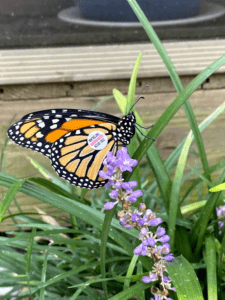
Monarch with tag ACGB 002 was the same tag that was recovered in El Rosario, Mexico.
Picture taken by: Olivia Wagner
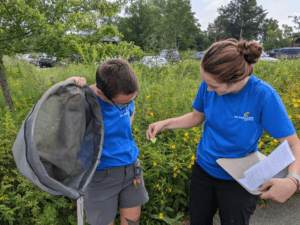
Interpretive rangers practice how to properly capture and hold butterflies in preparation for monarch tagging. Picture taken by: Erin Kinnetz
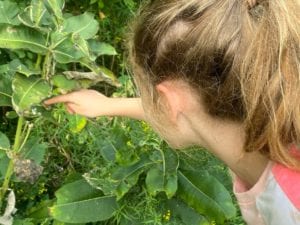
Forest learning lab students find monarch caterpillar on milkweed while tagging monarchs.
Picture taken by: Olivia Wagner
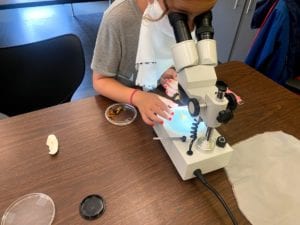
Forest learning lab student studies spent monarch chrysalis and monarch butterfly wings under a microscope. Picture taken by: Olivia Wagner
